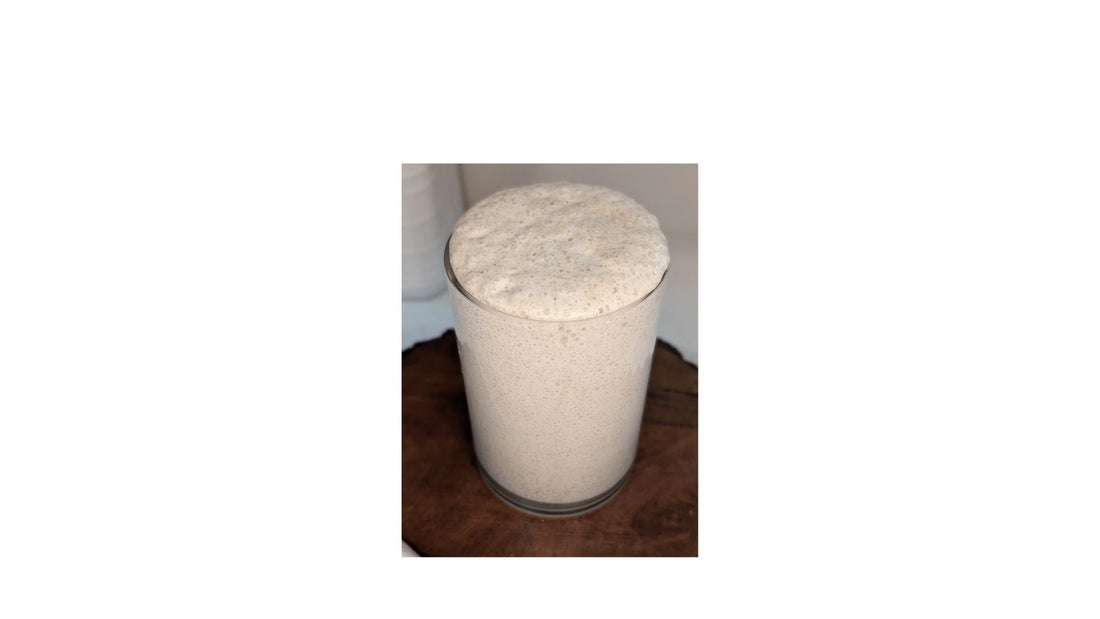
Bringing Dehydrated Sourdough Starter Back to Life
Share
Dehydrated starter is one of the simplest ways to share sourdough. It’s lightweight, easy to ship, and can stay dormant for months before being revived. Inside those little specks are wild yeast and lactic acid bacteria — the living culture that makes sourdough what it is. When we add water and flour back in, those microorganisms wake up, stretch, and slowly return to the lively community that powers your bread.
Think of it like planting a seed. The dried starter is alive but “asleep,” waiting for the right environment to grow again. Once you add water (to rehydrate it) and flour (its food), the microbes begin fermenting, producing bubbles, aromas, and eventually the strength to leaven bread.
How the Revival Process Works
- Hydration (Day 1): Adding water softens the flakes and reactivates the microbes. At this stage, the yeast and bacteria are “drinking in” their environment, soaking up the water so they can begin multiplying.
- First Meals: Once hydrated, we add small amounts of flour and water to provide food. Yeast consumes the natural sugars in flour, releasing carbon dioxide (the bubbles you’ll see), while bacteria produce lactic and acetic acids that give sourdough its flavor.
- Repetition: By feeding small, steady amounts over several days, you encourage the yeast and bacteria populations to grow. This is why we don’t start with a big feeding — the culture needs time to build strength.
- Maturity: A revived starter is considered “ready” when it can reliably double in size after feeding. This shows that the yeast population is strong enough to raise bread dough.
What You’ll Need
- 5g dehydrated sourdough starter
- A clean glass jar (8–12 oz works well to start)
- Filtered or dechlorinated warm water
- All-purpose or bread flour
- A spoon or small spatula for stirring
- Coffee filter or paper towel + band for covering
Day-by-Day Revival
Day 1 — Morning & Evening
- In a clean jar, mix 5g dried starter with 5g warm water. Stir well.
- Add 5g flour, mix thoroughly, and cover with a paper towel or coffee filter secured with a band.
- Let it sit for 12 hours.
Why? The first feeding rehydrates the dried starter and begins giving your microbes small amounts of food to wake them gently.
After 12 hours:
- Add 15g of warm water and 15g of flour.
- Stir well, cover, and let sit for another 12 hours.
What’s happening?
The starter is absorbing water and waking up. The microbes are still weak, but they’ve started digesting their first new meal in a long time.
Day 2 — Morning & Evening
- Discard all but 25g of the starter.
- Add 25g of warm water and 25g of flour.
- Stir thoroughly, cover, and let sit for 12 hours.
Why discard? Removing some of the starter keeps the balance right. Without discarding, you’d have to keep feeding bigger and bigger amounts, which quickly becomes wasteful. This step keeps the culture healthy and manageable.
Day 3 Onward
- Continue the Day 2 process (discarding all but 25g and feeding with 25g each of water and flour) every 12 hours.
- Repeat for 3–7 days, depending on how quickly your starter strengthens.
What to watch for: At first, activity may be subtle — a few bubbles or a light tangy smell. Over time, the rise will become more dramatic. When your starter consistently doubles in size within 4–8 hours after feeding and has a pleasant, slightly tangy aroma, it’s ready to use.
Knowing When It’s Ready
You’ll know your starter is strong when it:
- Doubles in size reliably after each feeding
- Has a network of bubbles throughout the jar
- Smells pleasantly tangy (not sharp or unpleasant)
- Feels spongy and airy when stirred
At this point, your revived starter is ready to join the rhythm of regular care and feeding.
Transitioning to Regular Care
Once your starter is active, bubbly, and reliable, begin feeding it using the same ratios bakers use for mature starters. If you’re unsure about ratios, I’ve written a full guide that explains how they work and how to choose the right one for your kitchen rhythm.
For a more in-depth look at feeding ratios, check out my article about Understanding Feeding Ratios (and what they do)
Understanding What’s Happening
- Hydration: Warm water softens the flakes and reactivates dormant yeast and bacteria.
- Fermentation: The yeast consume flour sugars and releases carbon dioxide (bubbles), while bacteria create lactic and acetic acids that add flavor.
- Strength Building: Regular feedings encourage the yeast population to multiply, making your starter more resilient each day.
- Readiness: A strong starter doubles after feedings and has a balanced aroma — not harsh, but pleasantly tangy.
- Microbes: Tiny living organisms (in this case, wild yeast and lactic acid bacteria) that power fermentation.
- Fermentation: The process in which microbes consume flour and water, releasing gas (bubbles) and acids (flavor).
- Hydration: Adding water to the dried starter to bring it back to life.
- Lactic & Acetic Acid: The natural acids created by bacteria — lactic acid gives a mild tang, while acetic acid adds sharper sour notes.
The Beauty of Reviving a Starter
There’s a quiet joy in watching something dormant come back to life. Within a few days, your jar will go from a paste of flour and water to a thriving, bubbling culture — a living companion that connects you to bakers across generations. With patience and care, your revived starter will not only raise bread but also build confidence and tradition in your kitchen.
